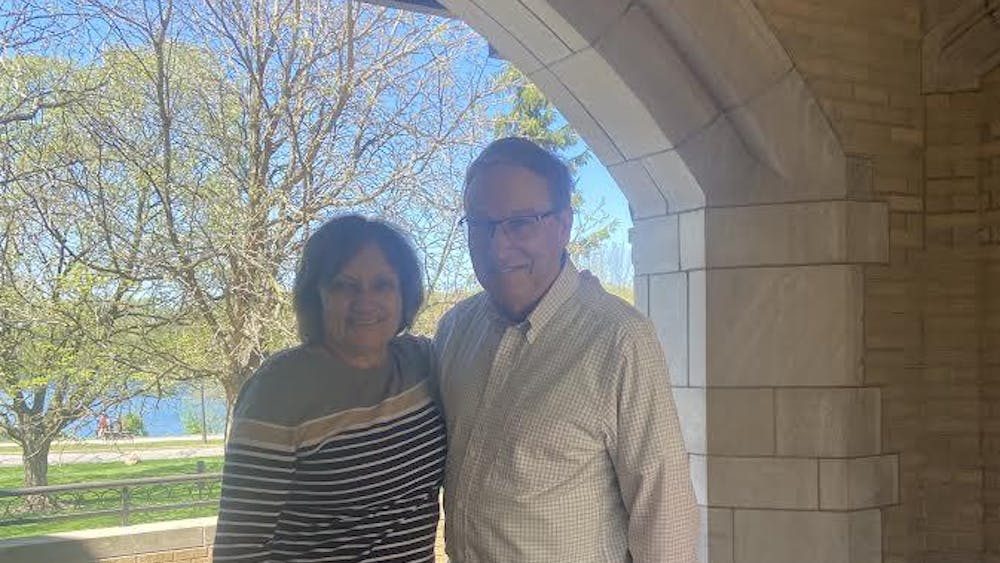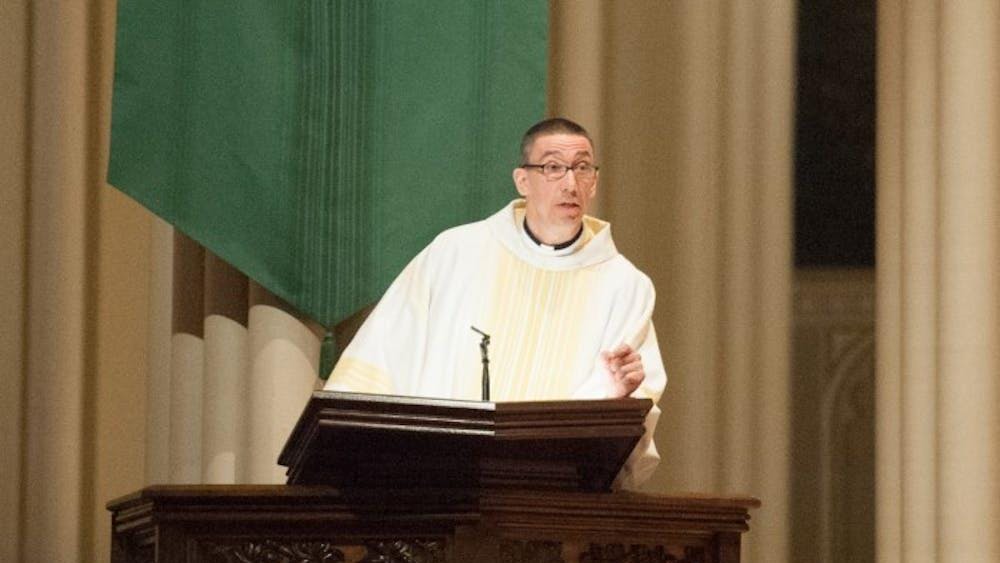On Oct. 27, the Glynn Family Honors Program celebrated the opening of its new, 1,500 square-foot lounge on the second floor of O’Shaughnessy Hall with apple cider and donuts.
For the 400 undergraduate students in the Glynn program, the multipurpose common room will serve not only as private study space, but also as a hub for Glynn-specific events like alumni speakers and senior thesis workshops, program co-director Margaret Meserve said.

The Glynn program offers select undergraduates in Notre Dame’s College of Arts and Letters, College of Science and School of Architecture “the opportunity to pursue academic excellence within a community of like-minded learners,” according to the program’s website.
“It's an honors program for academically ambitious, intellectually curious students in Arts and Letters, Science and Architecture,” Meserve said.
Notre Dame developed an honors program in the 1980s and in 2006, the program became known as the Glynn Family Honors Program, growing to its present size of about 100 students per year.
In the program’s current form, Meserve distinguishes two primary features: a unique path through Notre Dame’s core curriculum and sponsorship for undergraduate research which Glynn students are expected to integrate into their senior thesis.
“The support for research and the sense that you're going through Notre Dame with a cohort of other people who are also doing research and thinking about a senior thesis is also a really great opportunity,” Meserve said.
Reimagining humanities spaces

Over the past decade, academic programs all across Notre Dame’s College of Arts and Letters have been receiving makeovers.
On the third floor of O’Shaughnessy Hall — the location of Glynn’s old 1,250 square-foot lounge — the honors program will be saying goodbye to their neighbors, the program of liberal studies (PLS) student lounge.
But down on the second floor of O’Shaughnessy, the Glynn program will welcome as neighbors the newly remodeled Tech Ethics Lab and Reilly Center for Science, Technology and Values.
These aforementioned departmental areas and several others in O’Shaughnessy and Decio Halls have been renovated in recent years as a consequence of the $400 million Campus Crossroads project, Meserve said.
“If you go back to 2015 or 2016, Campus Crossroads, which is the buildings by the stadium, opened up, including new buildings for anthropology and psychology and music,” Meserve said. “And at the same time, Jenkins Nanovic Halls, down towards the south end of campus, opened up with new space for political science, sociology and economics.”
Easily half the College of Arts and Letters suddenly had new departmental suites built on a new model designed to facilitate student-faculty interaction.
“For the very first time, those are integrated spaces where the department office, all the faculty offices, graduate students, undergraduates, classrooms, lounges, the mail room, the coffeemaker — everything was under one roof,” Meserve said.
Faculty offices, which had previously been found in the crevices of Decio, Malloy and Flanner Halls, were reconnected with the main department office — former “storefronts,” which used to be located in either O’Shaughnessy or Flanner Halls.
Thirty to 40 years ago, “your office was in Decio, it was in Malloy, it was on another floor of Flanner not near the department,” Meserve said. “When I started at Notre Dame, Decio felt like a dorm for faculty. It was like 250 single offices and not even like a bench in the hallway, just absolutely like little cells lined up.”
Under the old model, neither students nor faculty in the humanities had any sense of an academic home on campus.
“The idea is to bring the faculty all together,” Meserve said, “But also, for me, it was very important to feel like if you are an undergraduate here and you declare a humanities major, you have a place to go that feels like your own.”
Meserve, who has been managing these renovation projects for the College of Arts and Letters in O’Shaughnessy and Decio Halls, said that so far, Notre Dame has done projects for: history, English, East Asian languages, German and Russian languages, PLS and smaller programs as well — “taking this empty space and trying to reimagine it.”
The classics department is receiving their renovation over winter break and a new project is currently underway for the Initiative on Race and Resilience on the third floor of O’Shaughnessy.
“The last few departments that we have to do are American studies and Romance languages. And those are in the planning stages,” Meserve said. “Eventually, every humanities program will be in a new space and thus far, we're more than halfway there.”
The new Glynn program lounge, known affectionately as the “Glounge” by its students, is complete with an open study area plan, faculty offices and fresh Einstein Bros. Bagels brought in every morning.
John W. Glynn '62 and his wife, Barbara, have maintained their financial backing of the program throughout its most recent evolution.
“We are very grateful to the Glynns who continue to support the program, they gave a gift that made this renovation possible,” Meserve said. “We're very excited, it's a beautiful new space ... We're really pleased with what we've been able to do.”
A unique path
The centerpiece of the Glynn program is a two-semester, first-year honors humanities seminar taught by the same professor to a small group of about a dozen students. The reading and writing intensive course fulfills the core curriculum’s writing and rhetoric and University seminar requirements.
Meserve said that the seminar is meant to be an encounter with literature and the intellectual history of primary texts.
“The idea is that, in the course of a year, you should cover a broad range of chronology, different authors, different voices, different kinds of texts,” she said. “We let every professor set their own syllabus, and some of them will choose a theme, like tragedy or war, or [they will] focus on the Catholic intellectual tradition or the environment.”
Seminars’ syllabi span literary history, touching upon authorities from Plato to Dante to Tolkien.
“[Professors] usually set books on the syllabus that go from the Old Testament or the Iliad and the Odyssey, all the way up to the twenty-first century,” Meserve said.

“The hope is that an exposure to literature of all stripes in the humanities seminar, that all these diverse encounters will compel students to question how they ought to understand calling in their own lives,” professor Jillian Snyder said.
Jack McEnery, a junior PLS major, remembered his “Gleminar” as a stimulating meeting of the minds between professor and students.
In addition to the humanities seminar, the Glynn course of studies includes honors philosophy, theology, science and mathematics courses, typically taken in the first or second year.
Notre Dame’s core curriculum requires that humanities majors complete a combination of three total math and science courses. Glynn students in the College of Arts and Letters must take one more for a total of two science and two math classes.
Scholarly excellence
Every Glynn student must write a senior thesis. Along the way, the Glynn program offers funding and students participate in research and writing colloquiums, Meserve said. Though it’s not required, students, for the most part, write their thesis with an advisor from their major. Topics are as variable as students’ interests.
“We have art students who do creative projects. Someone just did their piano recital as their senior project,” Meserve said. “Last year, we had a student who published their own children’s book.”
Emily Hannon, a senior history major, used Glynn funding to conduct research this summer at the Library of Congress on the development of American history textbooks
“I’m specifically looking at how the women’s liberation movement changed the way that women are discussed in American history textbooks,” she said. “My thesis is a little strange because it's more of historiography, which is the history of history.”
Hannon chose American Pageant, a common American high school textbook used for AP United States History initially published in 1956. A challenge with studying textbooks is that they are often destroyed when newer editions are released. The 17th edition of American Pageant came out in 2019.
“I used a Glynn grant to go to DC to go through all the editions of the textbook over the summer,” Hannon said. “The Library of Congress is one of the few places that actually keeps all of these old editions.”
Hannon intends on going to law school to work in the field of public education following graduation and anticipates a 40-to-80-page senior thesis with the history department to be ample preparation.
“Undertaking a long-scale writing and research project is really helpful for being a lawyer and managing thoughts,” she said. “[My research] will also give me more of a handle on how different forces engage in shaping public policy.”
The Glynn research and writing colloquiums, classes that Snyder teaches, serve as a memorable bookend, along with the humanities seminar, to the Notre Dame honors student experience.
Being back in these colloquiums with other Glynn students “is really cool to see, because it’s one of the weird things where your freshman year, you're together all the time and then you finish your requirements and go off into your major and don’t really see anyone,” Hannon said. “It’s cool to come back now and see what the students I had class with freshman year are doing now.”
You can contact Peter Breen at pbreen2@nd.edu











